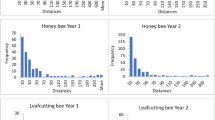Summary
Departure rules used by solitary long-tongued bees (Anthophora spp. andEucera spp.) collecting nectar from flowers ofAnchusa strigosa (Boraginaceae) were studied. The amount of nectar a bee receives from an individual flower was estimated by measuring the time elapsed since the previous bee visit to that flower. Measurements of nectar accumulation in experimentally emptied flowers indicated that this time interval is an accurate predictor of nectar volumes in flowers. We found that nectar rewards influence the probability of departure from individual plants, as well as distances of movements within plants. The probability of departure from individual plants was negatively related to the amount of reward received at the two lastvisited flowers. This result indicates that the bees used a probabllistic departure rule, rather than a simple threshold departure rule, and that rewards from both the current and the previously visited flower were important in determining departure points. Distances of inter-flower movements within plants were negatively related to the amount of reward received at the current flower. The overall results suggest that the pollinators ofA. strigosa make two types of departure decisions-departures from the whole plant and departures from the neighbourhood of individual flowers-and that they use different departure rules for each scale. Factors influencing the decision-making processes of the observed foraging behaviour are discussed.
Similar content being viewed by others
References
Best, L. S. and Bierzychudek, P. (1982) Pollinator foraging on Foxglove (Digitalis purpurea): a test of a new model.Evolution 36, 70–9.
Charnov, E. L. (1976) Optimal foraging: the marginal-value theorem.Theor. Pop. Biol. 9, 129–36.
Cresswell, J. E. (1990) How and why do nectar-foraging bumblebees initiate movements between inflorescences of wild bergamoMonarda fistulosa (Lamiaceae)?Oecologia 82, 450–60.
Feinbrun-Dothan, N. (1977)Flora Palestina, Vol. III. The Israel Academy of Sciences and Humanities, Jerusalem.
Hartling, L. K. and Plowright, R. C. (1978) Foraging by bumble bees on patches of artificial flowers: a laboratory study.Can. J. Bot. 63, 488–91.
Heinrich, B. (1979) Resource heterogeneity and patterns of movement in foraging bumble bees.Oecologia 40, 235–46.
Hodges, C. M. (1981) Optimal foraging in bumblebees: hunting by expectation.Anim. Behav. 29, 1166–71.
Hodges, C. M. (1985) Bumblebees foraging: the threshold departure rule.Ecology 66, 179–87.
Kadmon, R., Shmida, A. and Selten, R. (1992) Within-plant foraging behavior of bees and its relation to nectar distribution inAnchusa strigosa. Isr. J. Bot. (in press).
Maynard Smith, J. (1978) Optimization theory in evolution.Ann. Rev. Ecol. Systematics 9, 31–56.
McNamara, J. and Houston A. (1980) The application of statistical decision theory to animal behavior.J. Theor. Biol. 85, 673–90.
Ollason, J. G. (1980) Learning to forage-optimally?Theor. Pop. Biol. 18, 44–56.
Pleasants, J. M. (1989) Optimal foraging by nectarivores: a test of the marginal-value theorem.Am. Nat. 134, 51–71.
Pyke, G. H. (1978) Optimal foraging: movement patterns of bumblebees between inflorescenses.Theor. Pop. Biol. 13, 72–98.
Shmida, A. and Ellner, S. (1984) Coexistence of plant species with similar niches.Vegetatio 58, 20–55.
Shmida, A. and Kadmon, R. (1991) Within-plant patchiness in nectar distribution inAnchusa strigosa.Vegetatio 94, 95–9.
Stephens, D. W. and Krebs, J. R. (1986)Foraging Theory. Princeton University Press, Princeton, NJ, USA.
Waddington, K. D. (1980) Flight patterns of foraging bees relative to density of artificial flowers and distribution of nectar.Oecologia 44, 199–204.
Waddington, K. D. (1981) Factors influencing pollen flow in bumblebee-pollinatedDelphinium virescens.Oikos 37, 153–9.
Zimmerman, M. (1982) The effect of nectar production on neighborhood size.Oecologia 52, 104–108.
Zimmerman, M. (1983) Plant reproduction and optimal foraging: experimental nectar manipulations inDelphinium nelsonii.Oikos 41, 57–63.
Zimmerman, M. and Cook, S. (1986) Pollinator foraging, experimental nectar robbing and plant fitness inImpatiens capensis.Am. Midland Nat. 113, 84–91.
Zimmerman, M. and Pyke, G. H. (1986) Reproduction inPolemonium: patterns and implications of floral nectar production and standing crops.Am. J. Bot. 73, 1405–15.
Author information
Authors and Affiliations
Rights and permissions
About this article
Cite this article
Kadmon, R., Shmida, A. Departure rules used by bees foraging for nectar: A field test. Evol Ecol 6, 142–151 (1992). https://doi.org/10.1007/BF02270708
Issue Date:
DOI: https://doi.org/10.1007/BF02270708




